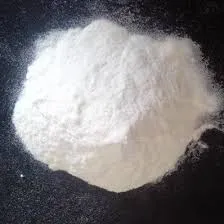
Dec . 03, 2024 17:10 Back to list
Exploring HPMC Characteristics and Their Impact on Formulation Development
Understanding HPMC Properties A Comprehensive Overview
Hydroxypropyl Methylcellulose (HPMC) is a versatile cellulose-derived compound that has gained significant attention in various industries, particularly in pharmaceuticals, food, and construction. This article delves into the properties of HPMC, elaborating on its chemical structure, functional applications, and the advantages it offers, contributing to its widespread use.
Chemical Structure and Composition
HPMC is a non-ionic polymer derived from cellulose, which is a natural polymer extracted from plant cell walls. The chemical modification process involves partial substitution of hydroxyl groups in cellulose with hydroxypropyl and methyl groups. This modification enhances the solubility of the cellulose in cold water, making it an ideal thickening, emulsifying, and binding agent. The degree of substitution and molecular weight of HPMC can be tailored to meet specific application requirements.
Physical Properties
One of the most significant properties of HPMC is its ability to form viscous solutions when dissolved in water. Depending on the viscosity grade, HPMC can create solutions that range from low to high viscosity, making it a versatile ingredient across various sectors. HPMC exhibits thixotropic behavior; that is, its viscosity decreases under shear stress and recovers when the stress is removed. This property is particularly beneficial in formulations requiring ease of application without compromising stability.
Furthermore, HPMC is known for its excellent film-forming capabilities. When applied as a coating, it forms a transparent, flexible film that can protect underlying surfaces or encapsulate active ingredients in pharmaceuticals and food products. This film-forming ability is vital for creating slow-release formulations, critical in enhancing therapeutic efficacy in drug delivery systems.
Applications in Pharmaceuticals
In the pharmaceutical industry, HPMC serves multiple roles. It is primarily utilized as a binder in tablet formulations, contributing to the integrity and compressibility of tablets. Additionally, its functionality as a controlled-release agent allows for the design of sustained-release medications, improving patient compliance by minimizing the frequency of dosage. HPMC is also employed as a stabilizer in suspensions and emulsions, ensuring consistent drug delivery.
hpmc properties

Its non-toxic and biocompatible properties further enhance its suitability for pharmaceutical applications. Many HPMC grades are approved for use in drug products and are designated as Generally Recognized as Safe (GRAS) by regulatory authorities such as the FDA.
Role in Food Industry
In the food sector, HPMC is recognized as a food additive, primarily serving as a thickener, emulsifier, and stabilizer. It improves the texture and mouthfeel of various food products, including sauces, dressings, and bakery items. HPMC is low-calorie and is commonly used in low-fat and low-carb products as a bulking agent without adding calories.
Moreover, due to its foam-stabilizing and emulsifying properties, HPMC is increasingly being used in plant-based formulations and dairy alternatives, enhancing product stability and shelf life.
Construction and Other Applications
HPMC has also made remarkable inroads in the construction industry. It is commonly used in mortar formulations and tile adhesives due to its water retention properties, which improve workability and adhesion. These properties ensure that cement mixtures remain workable for more extended periods, allowing for better application and finishing.
In addition, HPMC is utilized in personal care products, such as shampoos and lotions, where it acts as a thickening agent, providing a favorable viscosity and improving the overall sensory experience of the product.
Conclusion
In summary, Hydroxypropyl Methylcellulose (HPMC) showcases a wide array of properties that render it indispensable across multiple industries. Its versatility, combined with its functional advantages, such as viscosity modulation, film formation, non-toxicity, and biocompatibility, underscore its importance in pharmaceuticals, food processing, construction, and personal care applications. As industries continue to innovate and prioritize sustainability, HPMC's role is bound to expand, cementing its place as a critical ingredient in modern formulations.
-
Versatile Hpmc Uses in Different Industries
NewsJun.19,2025
-
Redispersible Powder's Role in Enhancing Durability of Construction Products
NewsJun.19,2025
-
Hydroxyethyl Cellulose Applications Driving Green Industrial Processes
NewsJun.19,2025
-
Exploring Different Redispersible Polymer Powder
NewsJun.19,2025
-
Choosing the Right Mortar Bonding Agent
NewsJun.19,2025
-
Applications and Significance of China Hpmc in Modern Industries
NewsJun.19,2025







